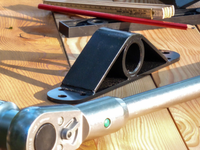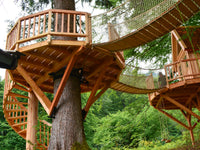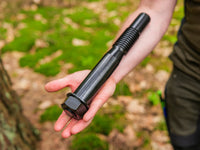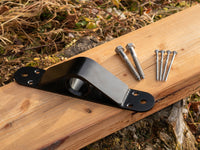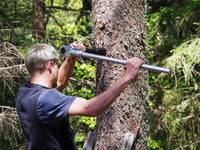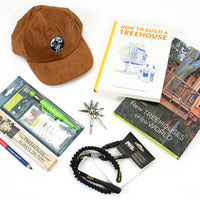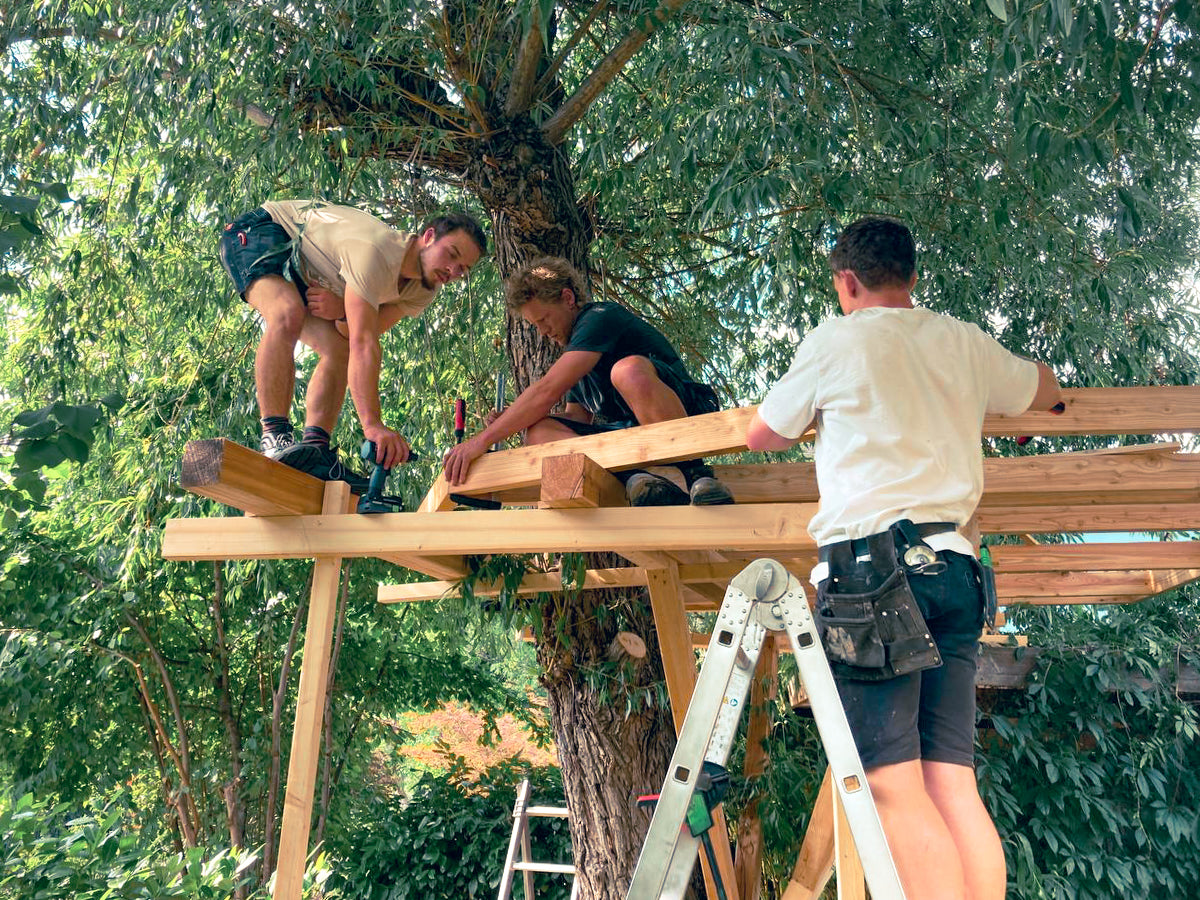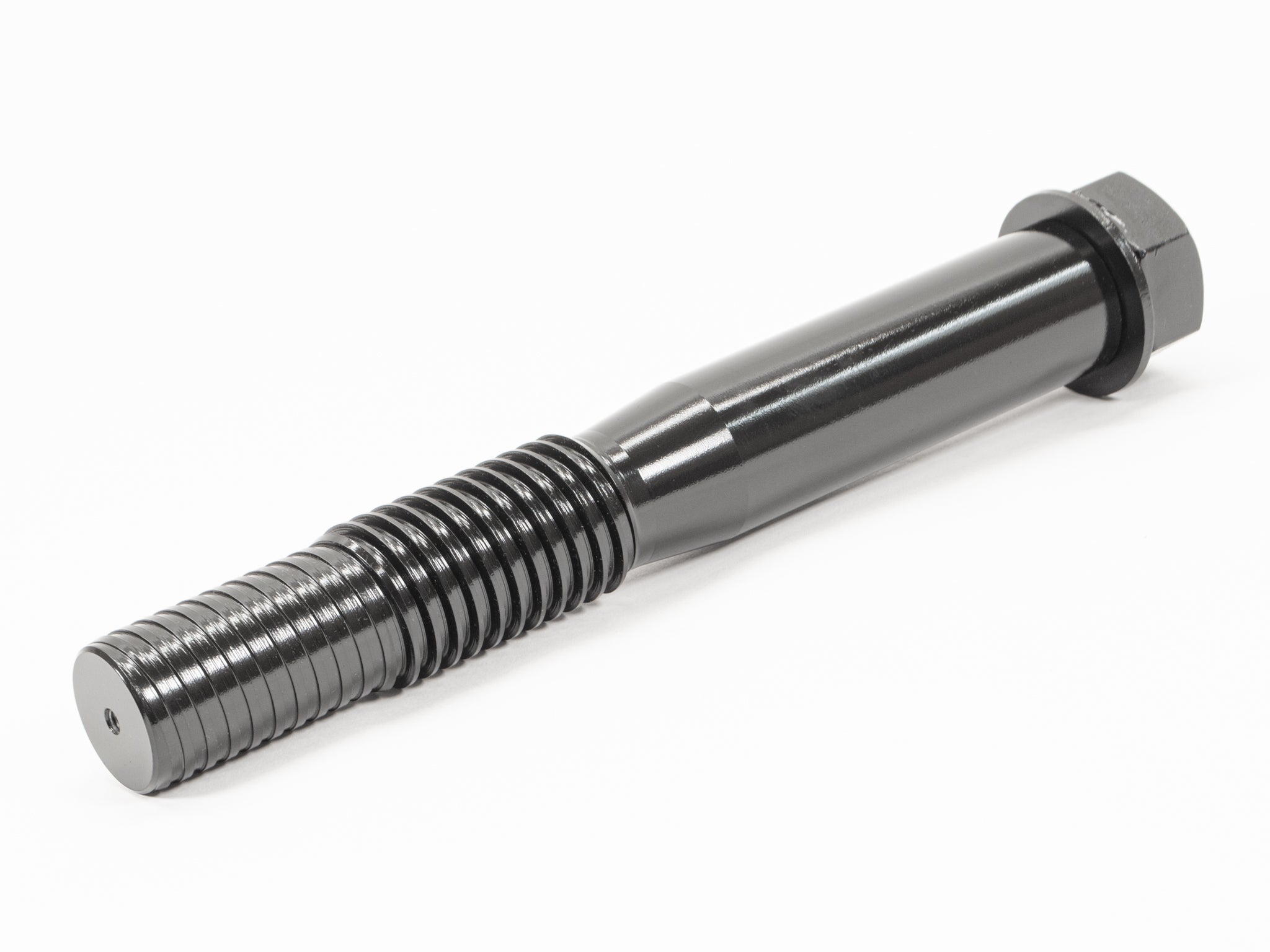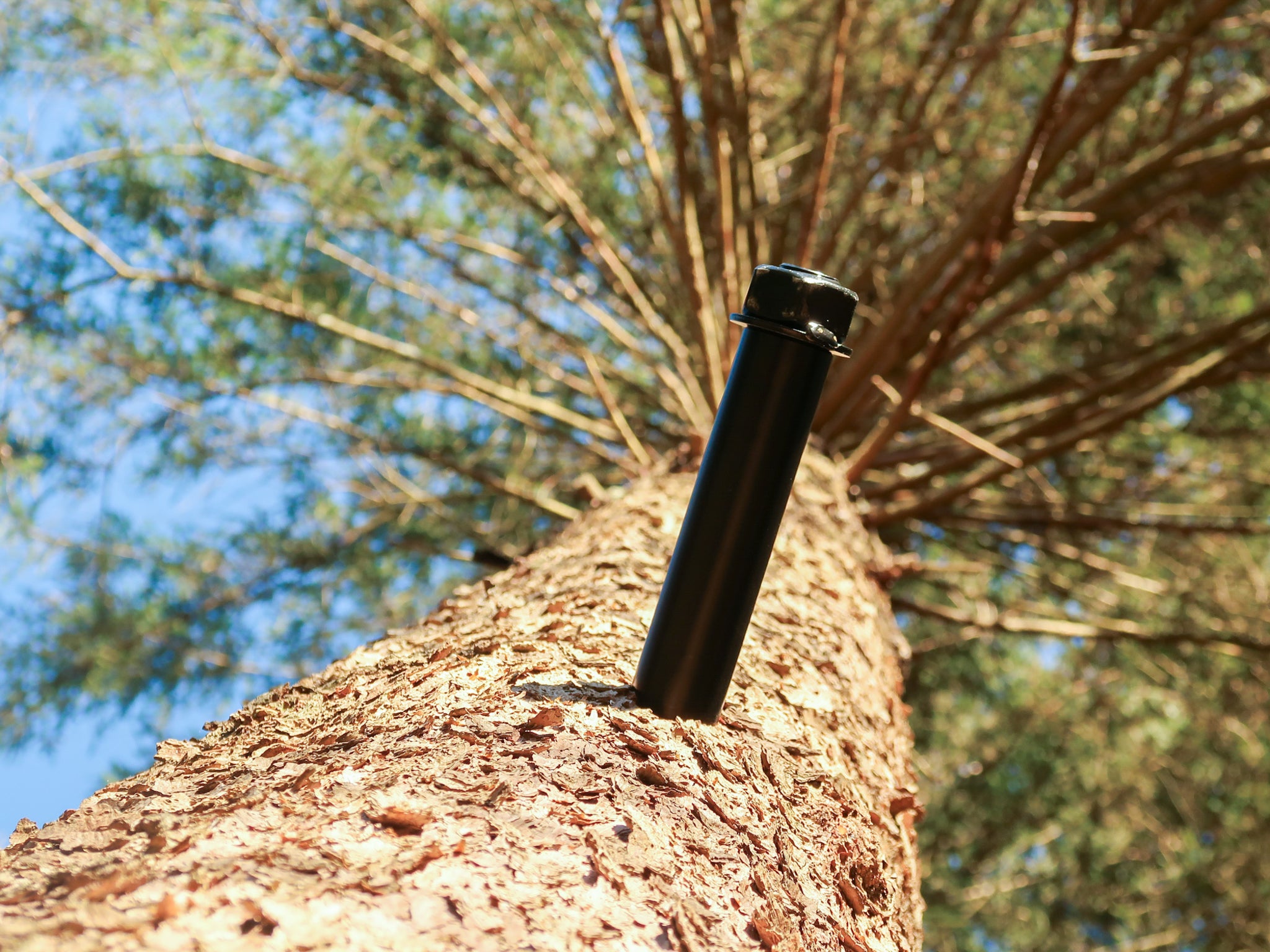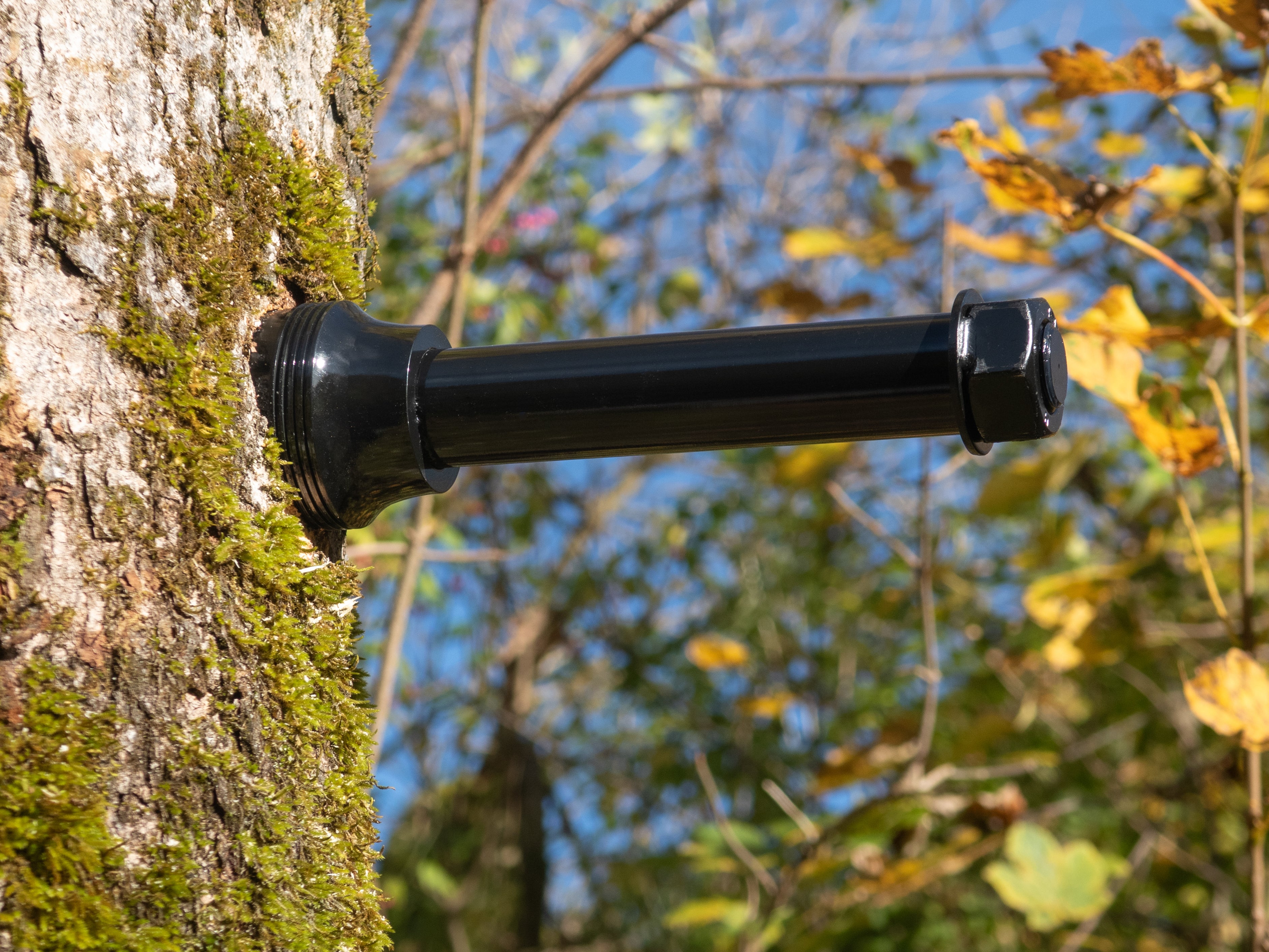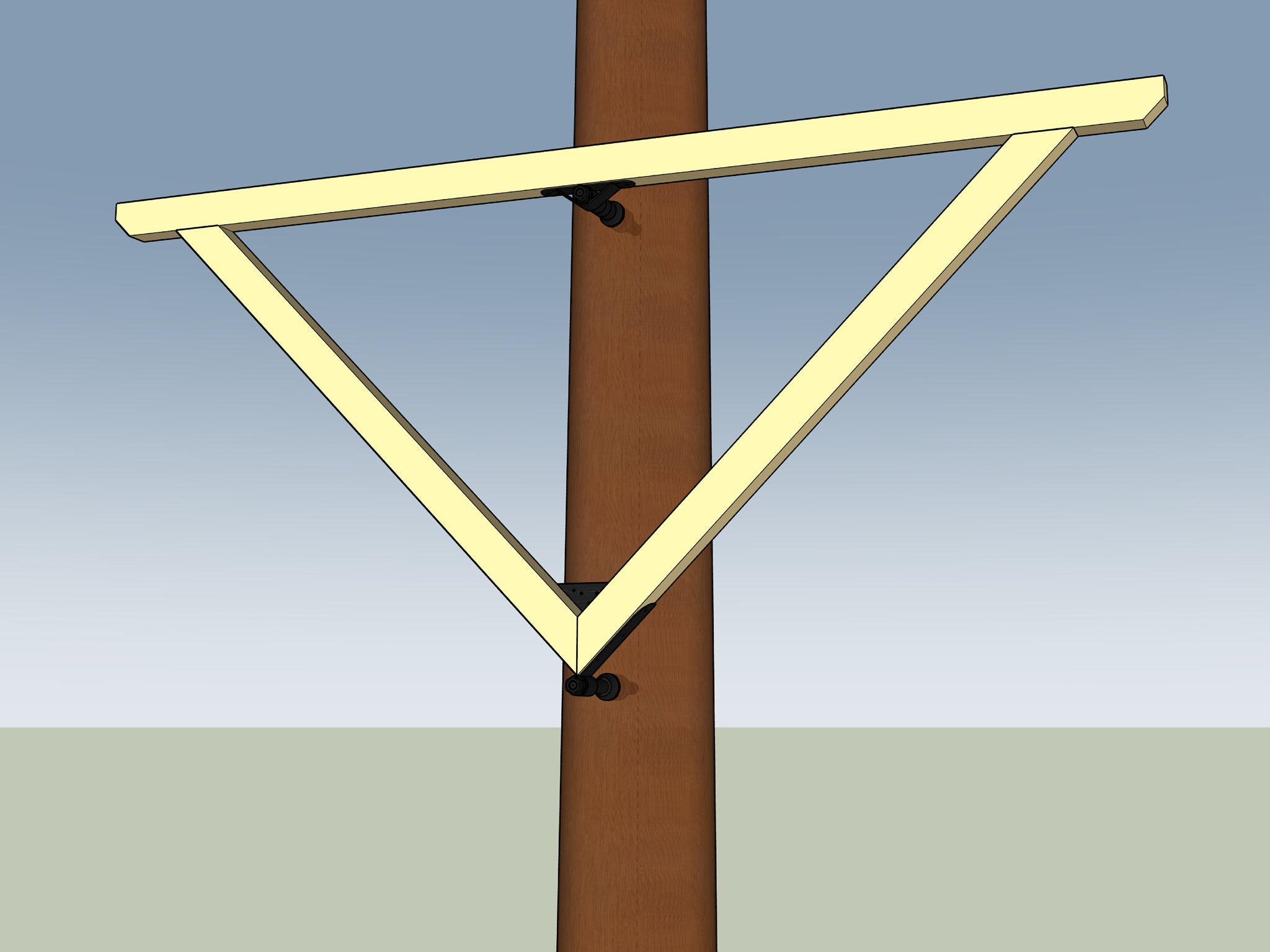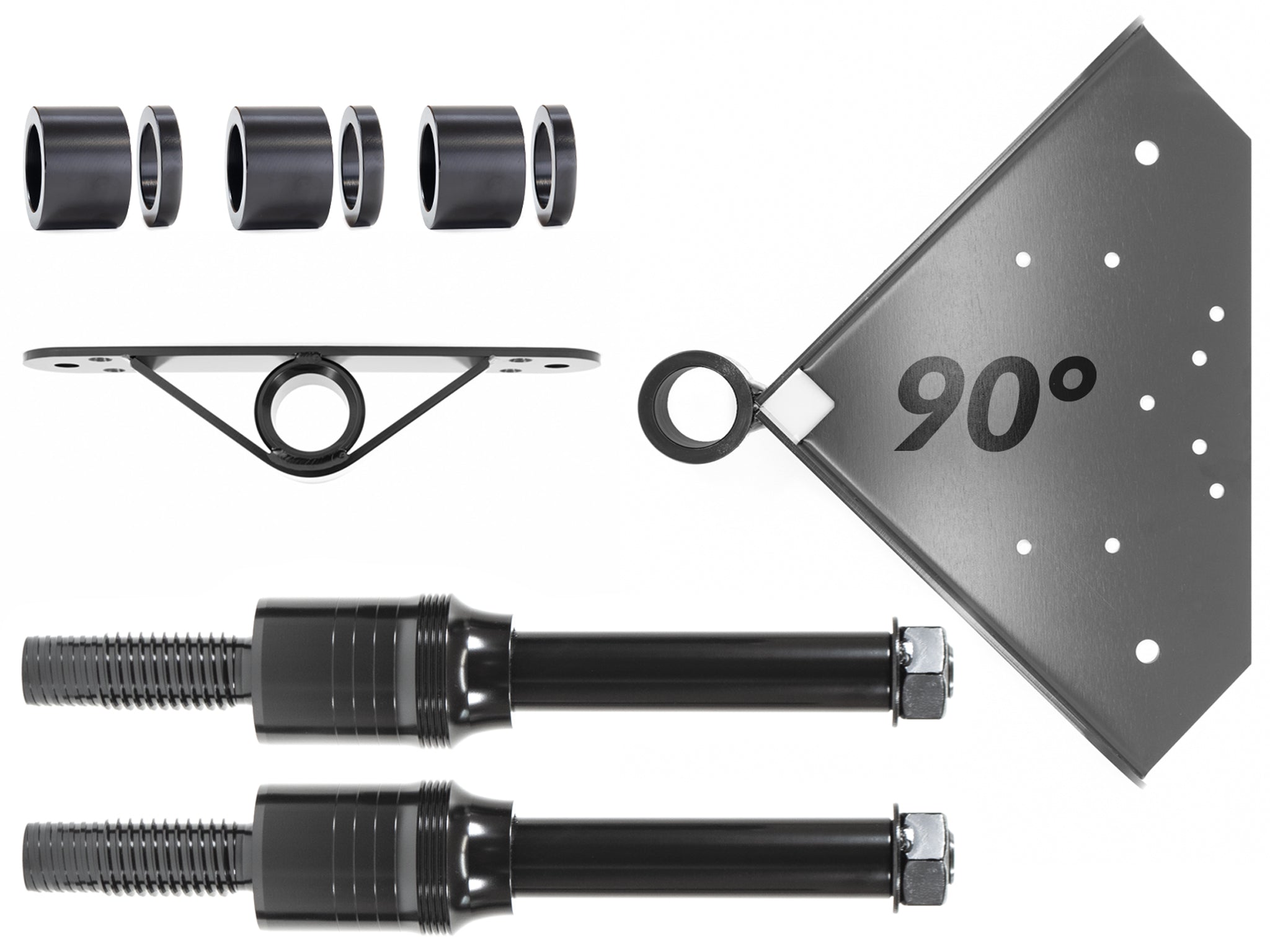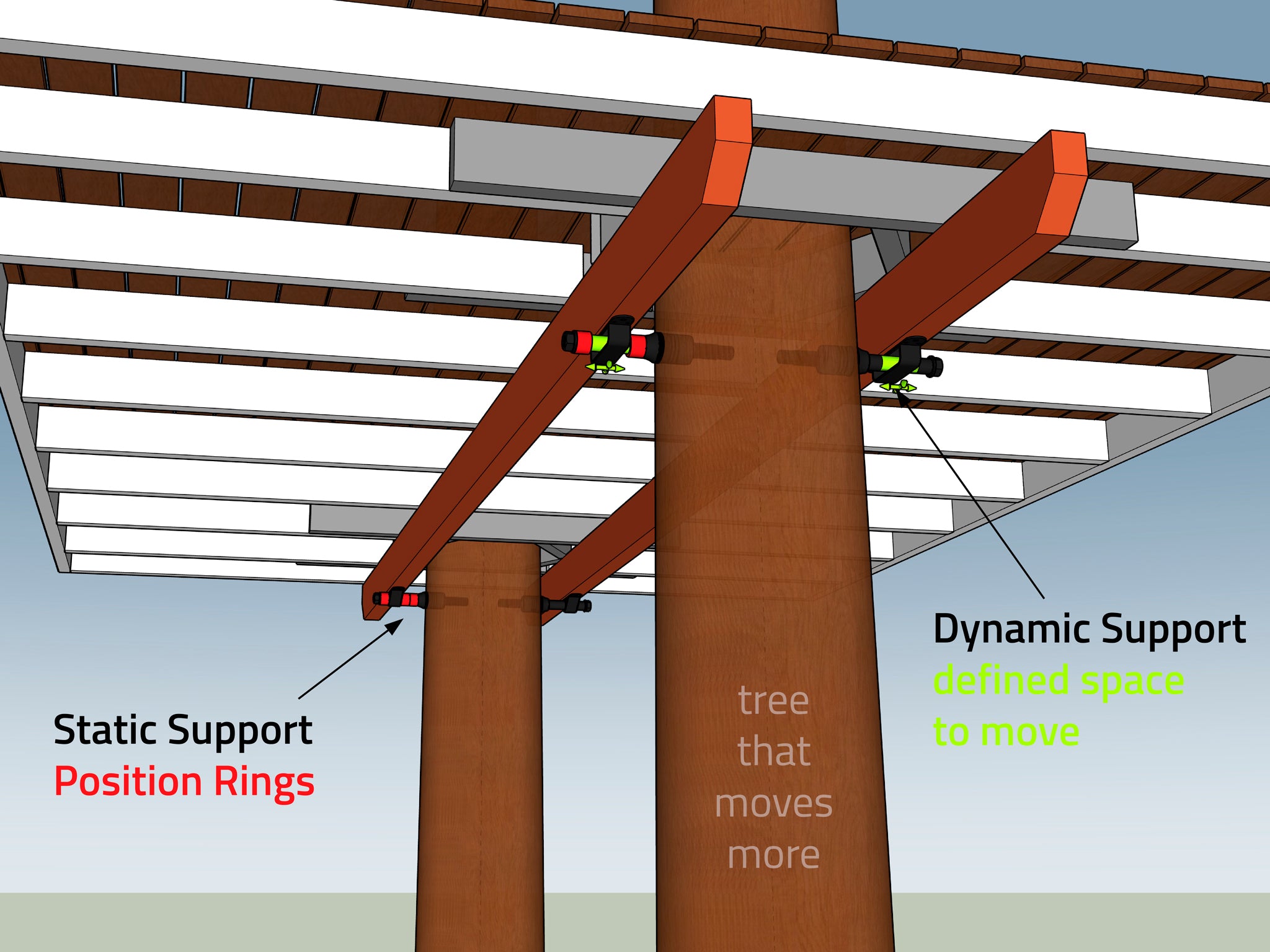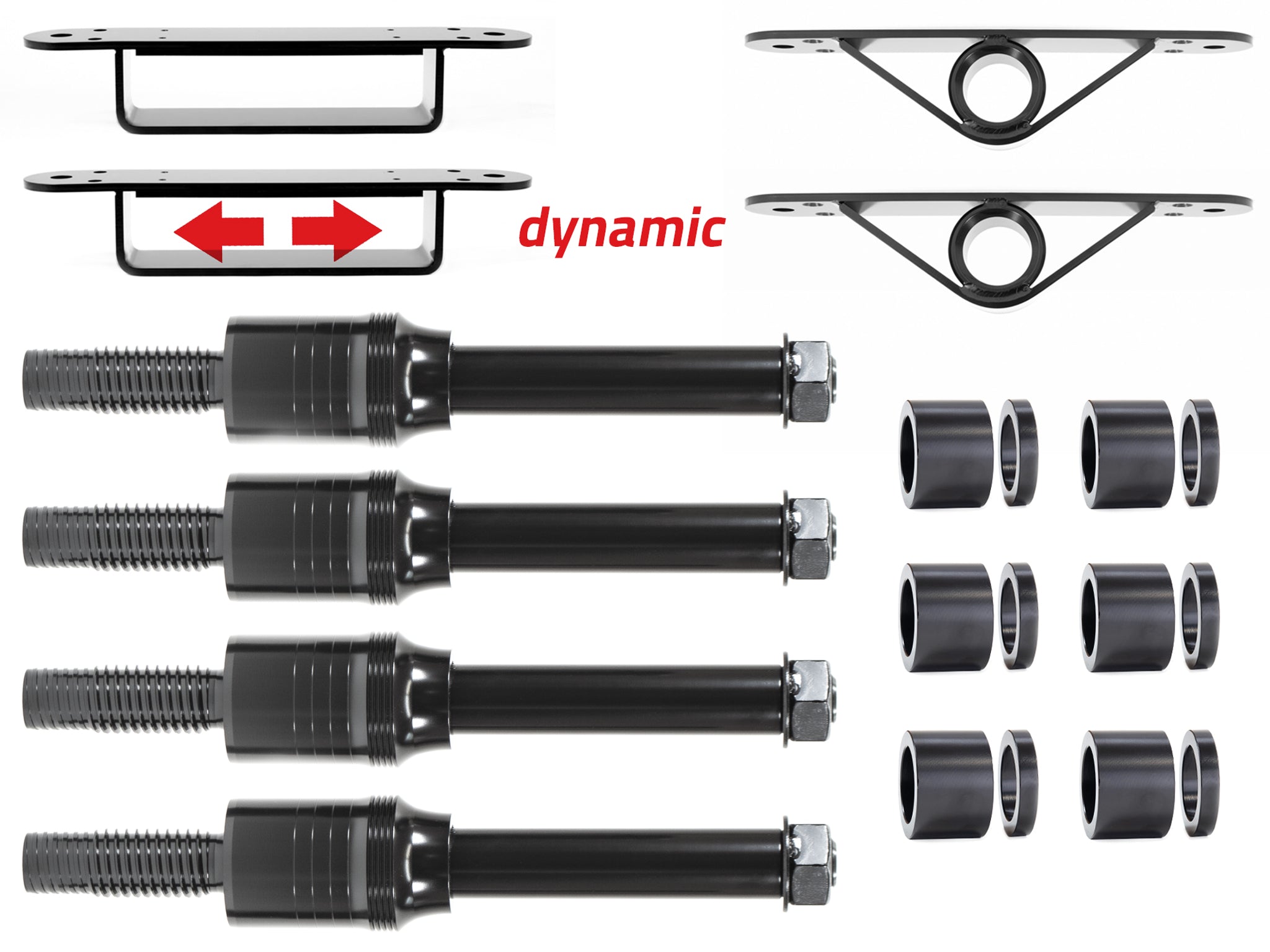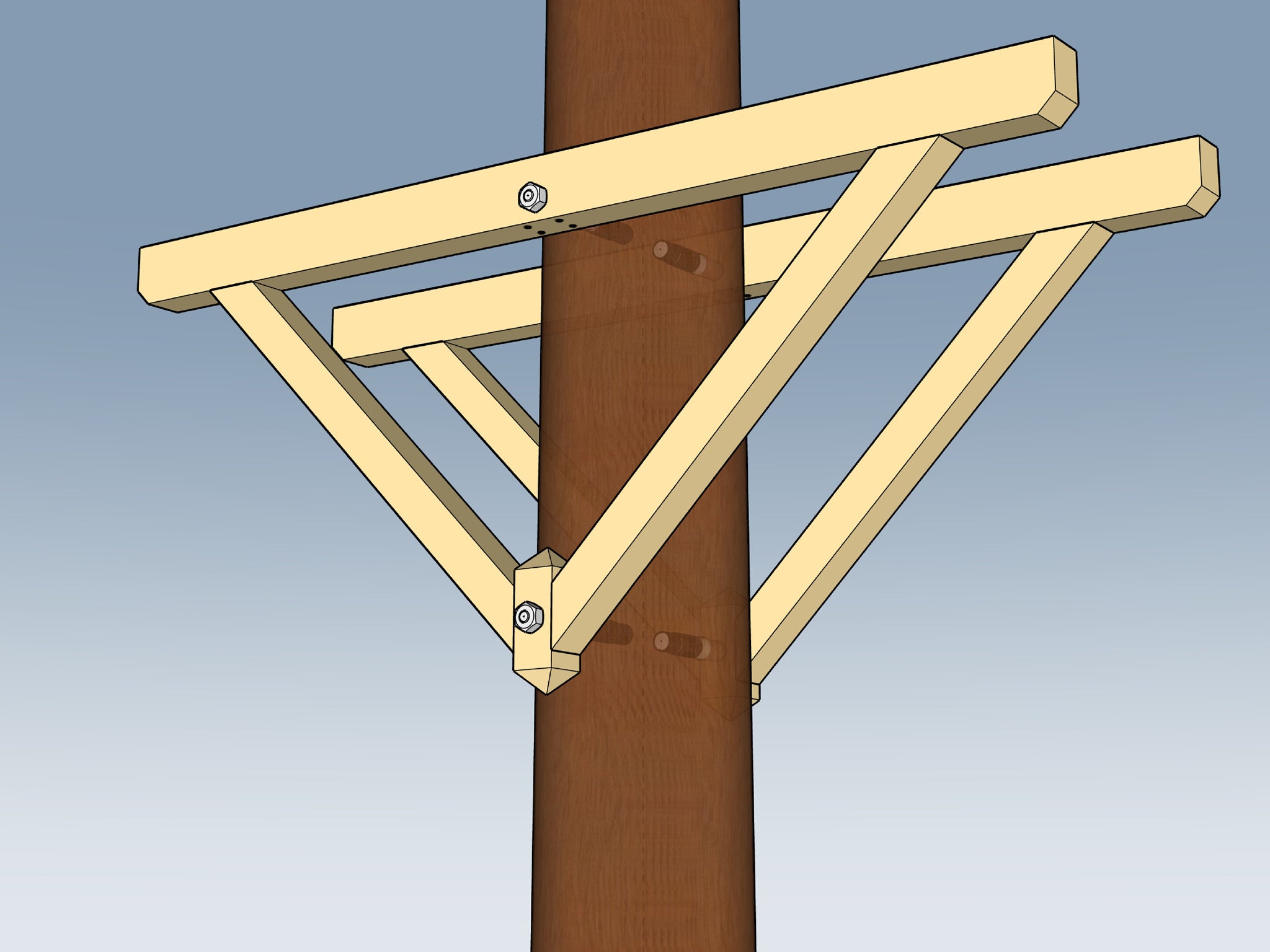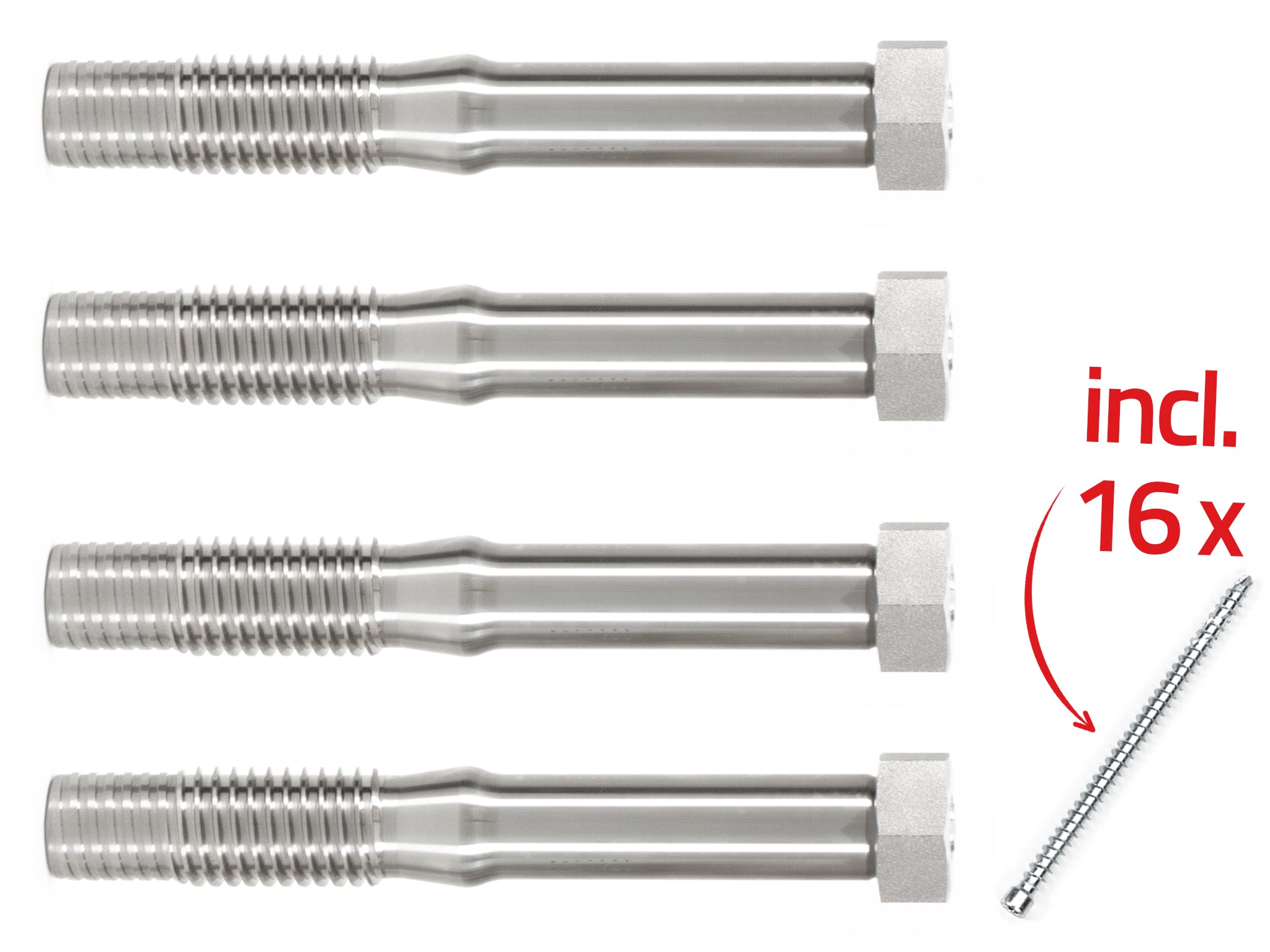Step 6: Are screws and bolts harmful to the tree?
In a nutshell:
✔ Individual screws and nails do not kill the tree
✔ Trees grow around foreign objects and integrate them permanently
✔ The tree must be healthy and have good wound healing properties
✔ There are tree bolts specially designed for living trees
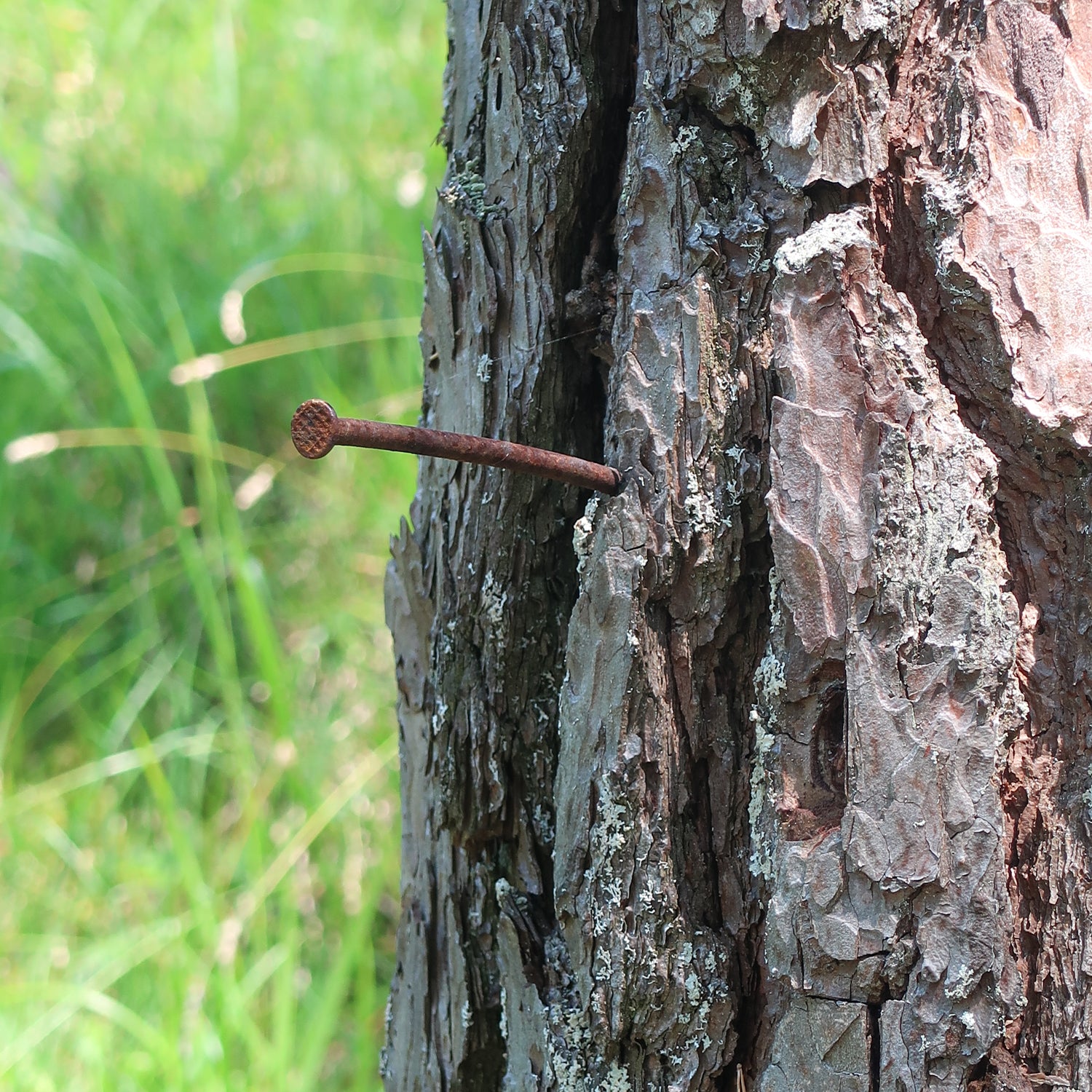
Damage to the tree due to incorrect fastening? Screw, nail, threaded rod or TAB – what is the best solution in the long term?
If you want to attach something to a tree, such as a small sign, a birdhouse, a swing beam or, as in our case, an entire treehouse, you often hear people say:
‘Screws damage the tree! One copper nail and the whole tree will die!’
Many people are understandably afraid of screwing a piece of steel into a living tree because they think it will cause irreversible damage.
But is a small hole really a danger to the whole tree? How does the tree tolerate the foreign object steel? Are tension straps or clamping methods a better alternative? Here we address these concerns in more detail:
To this day, there is no scientific evidence that steel, stainless steel, copper or aluminium harm trees or ‘poison’ them through rust and other means.
1. Concern: Will the tree repel foreign objects?
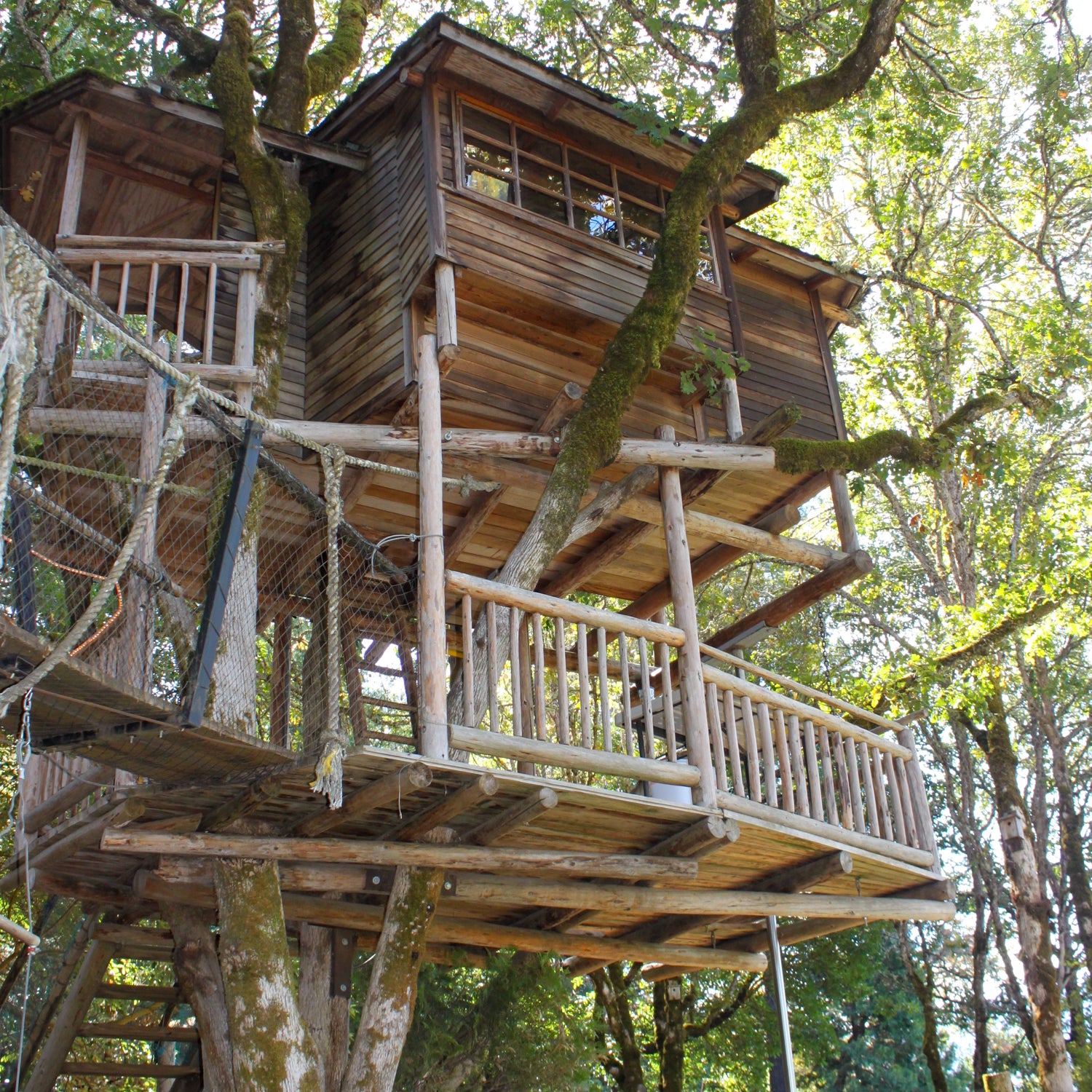
Living proof
There are few places where you can observe the interplay between steel and living trees better than at the Out'n'About Treehouse Resort with its 15 treehouses, huge climbing forest, suspension bridges, zip lines and a total of over 50 platforms. This legendary place in Oregon, USA, is both the birthplace and a kind of museum of modern treehouse construction.
For over 30 years, a wide variety of attachment methods have been tried and tested on trees: threaded rods, steel beams, clamp constructions with wooden beams, rope fastenings... The first modern treehouse bolts were also developed here: ‘Garnier Limb’ and ‘Treehouse Attachment Bolt TAB’.
Here you can see the first attempts at tree fastenings for treehouses:
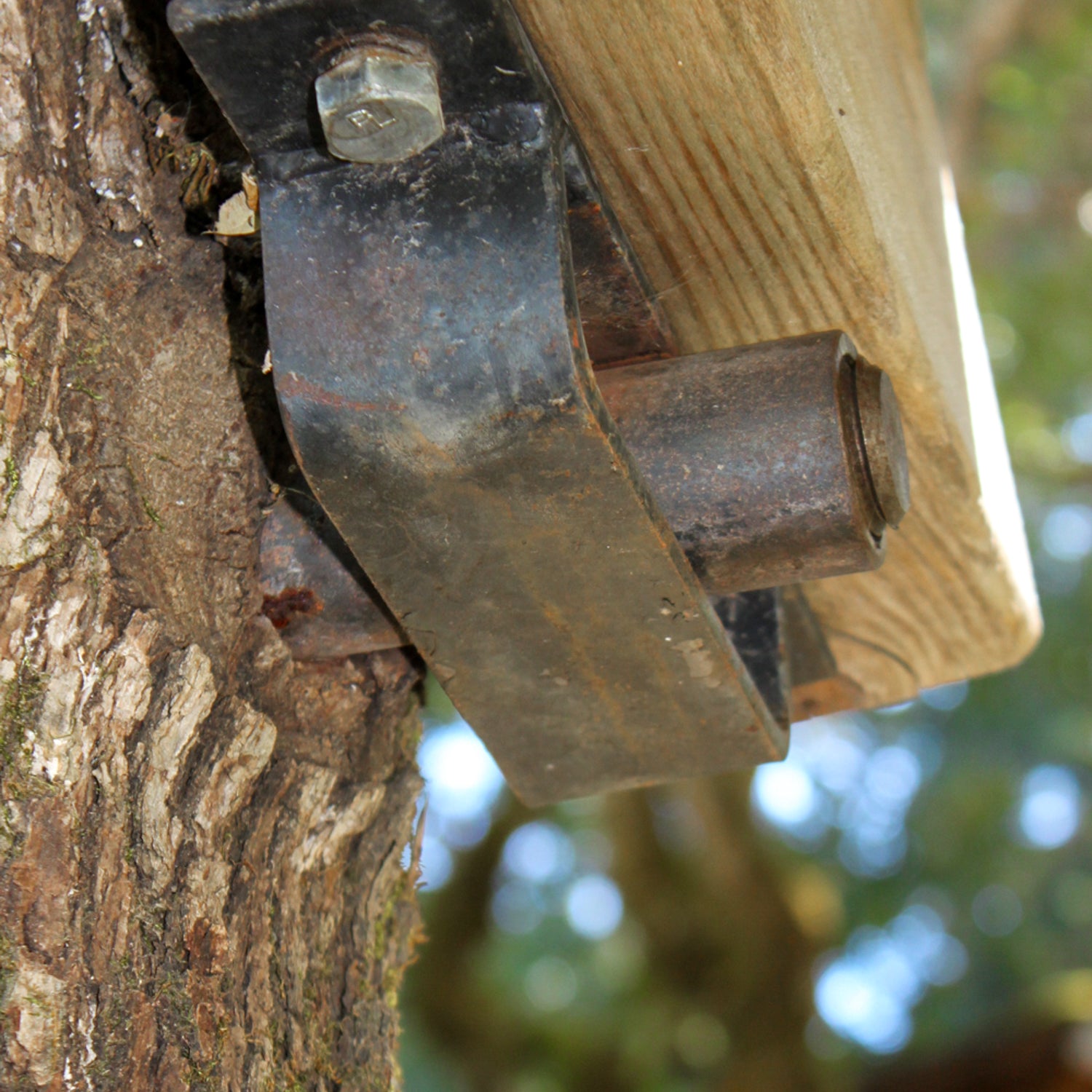
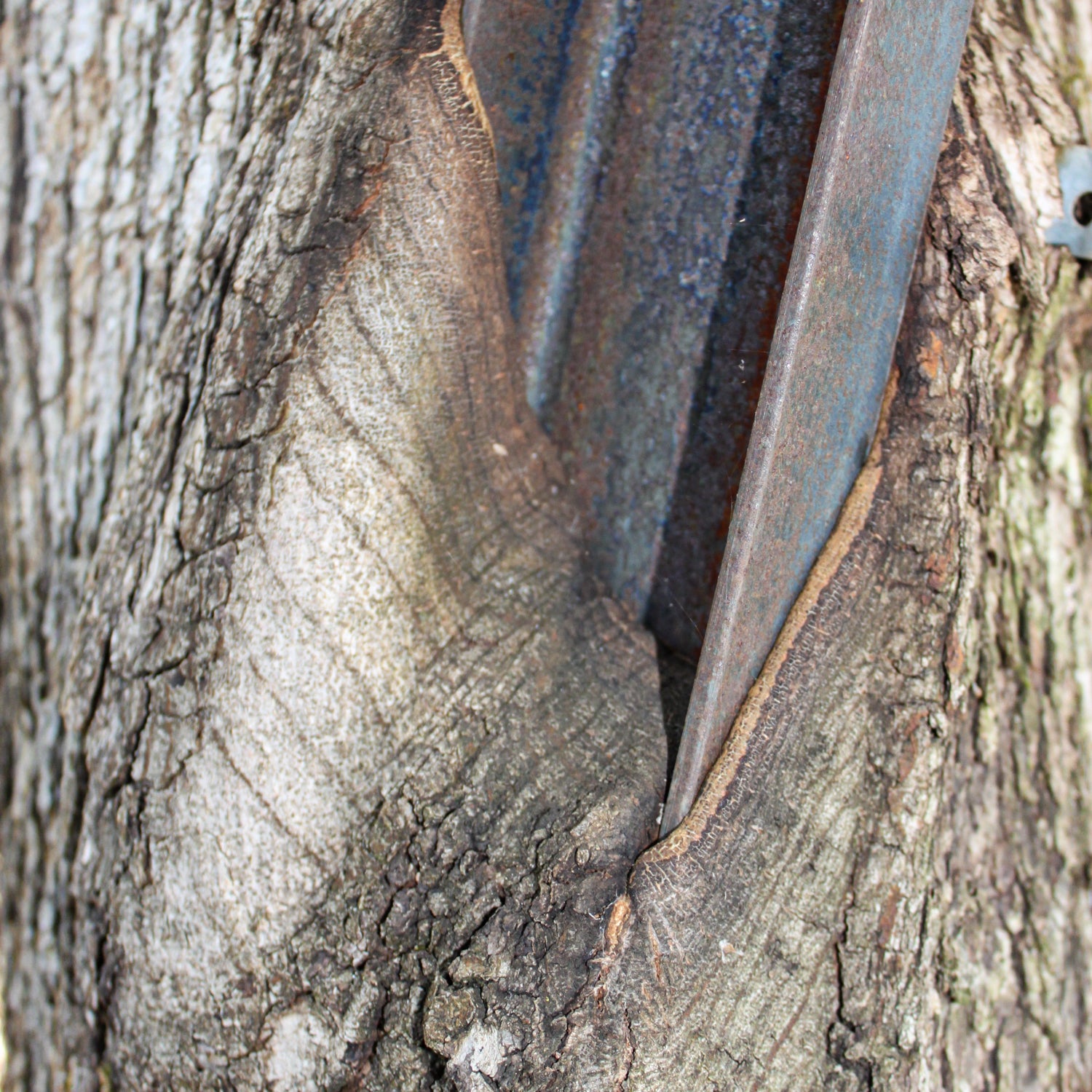
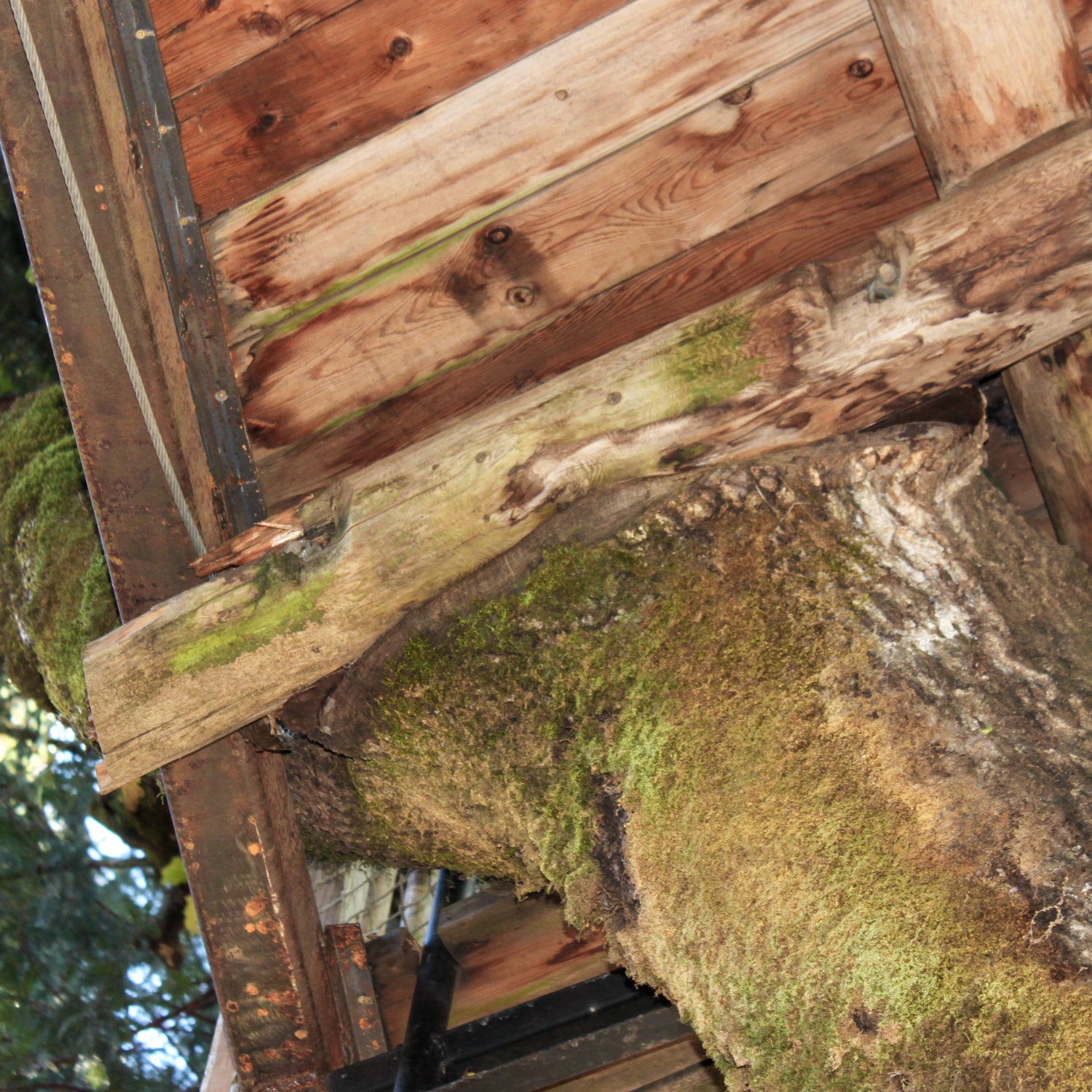
Wooden beams directly from the tree
Screwing a beam directly to the tree quickly proved to be a bad idea, as water collects at the contact points and the beam can rot and break. It also hinders the tree's growth.
Steel beam on tree
The treehouse pioneers also experimented extensively with steel beams. The tree integrates the complicated shape of the beams smoothly into the trunk. However, here too, the tree is largely prevented from growing, creating dangerous predetermined breaking points.
The first treehouse bolts
The first professional tree bolts (Garnier Limb & Treehouse Attachment Bolt TAB) were developed as a solution. With enormous load capacity, they also keep the treehouse construction at a distance so that the tree can grow undisturbed – the birth of modern treehouse construction!
If you look closely, you will see how trees deal with obstacles everywhere – they simply grow around them, enveloping foreign objects and making them part of their lives. Natural integration in perfection!
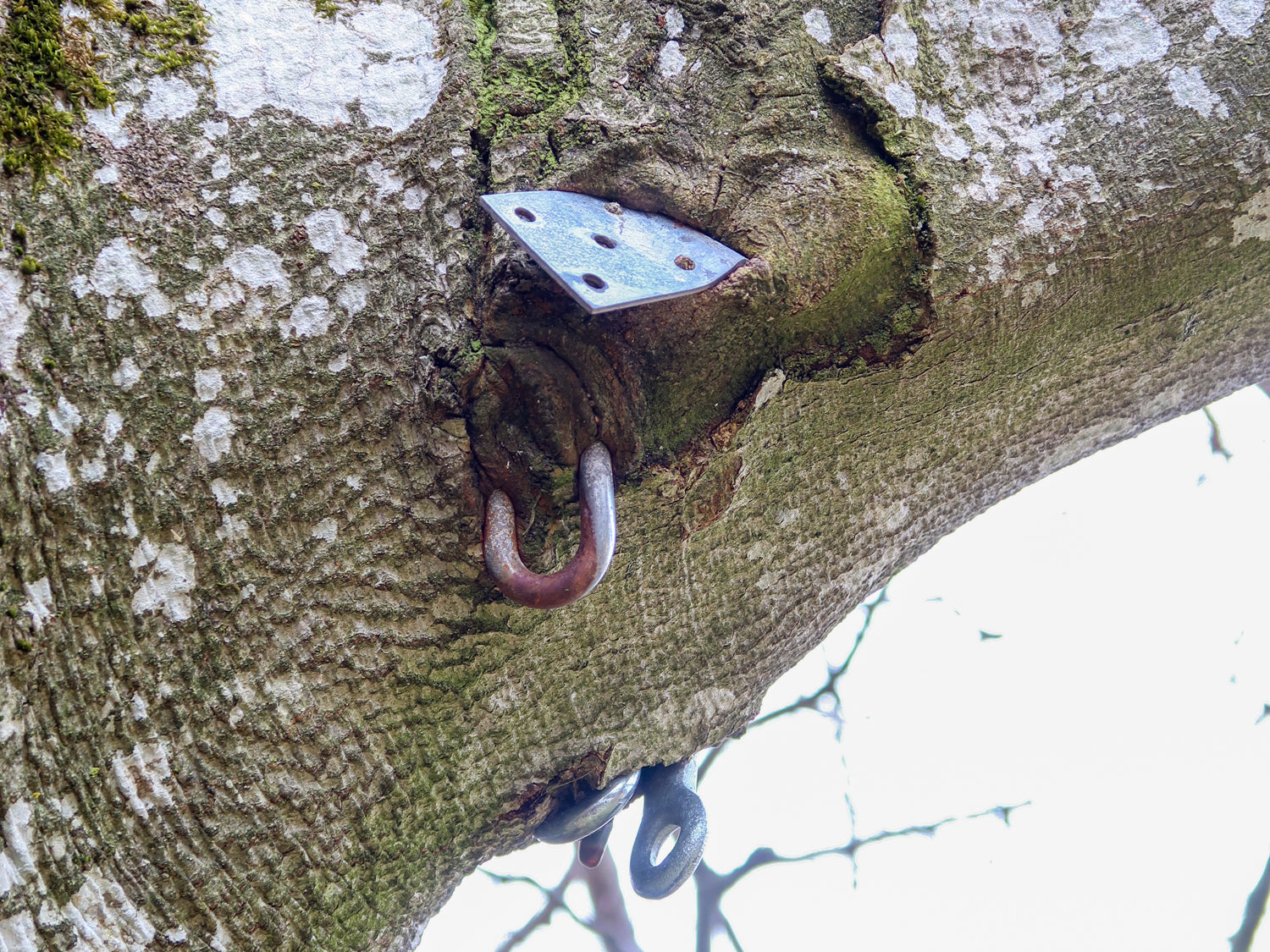
growth in thickness
Trees grow between 3 and 15 mm in width each year, which is clearly visible in the annual rings. This growth in thickness allows the tree to literally ‘swallow’ foreign objects. It recognises which wood is needed at a wound and adapts to the new load.
The tree does not reject the foreign object, but adapts to its shape and integrates the steel parts into its wooden body without any problems!
2. Concerns: Will nails and screws damage the tree?
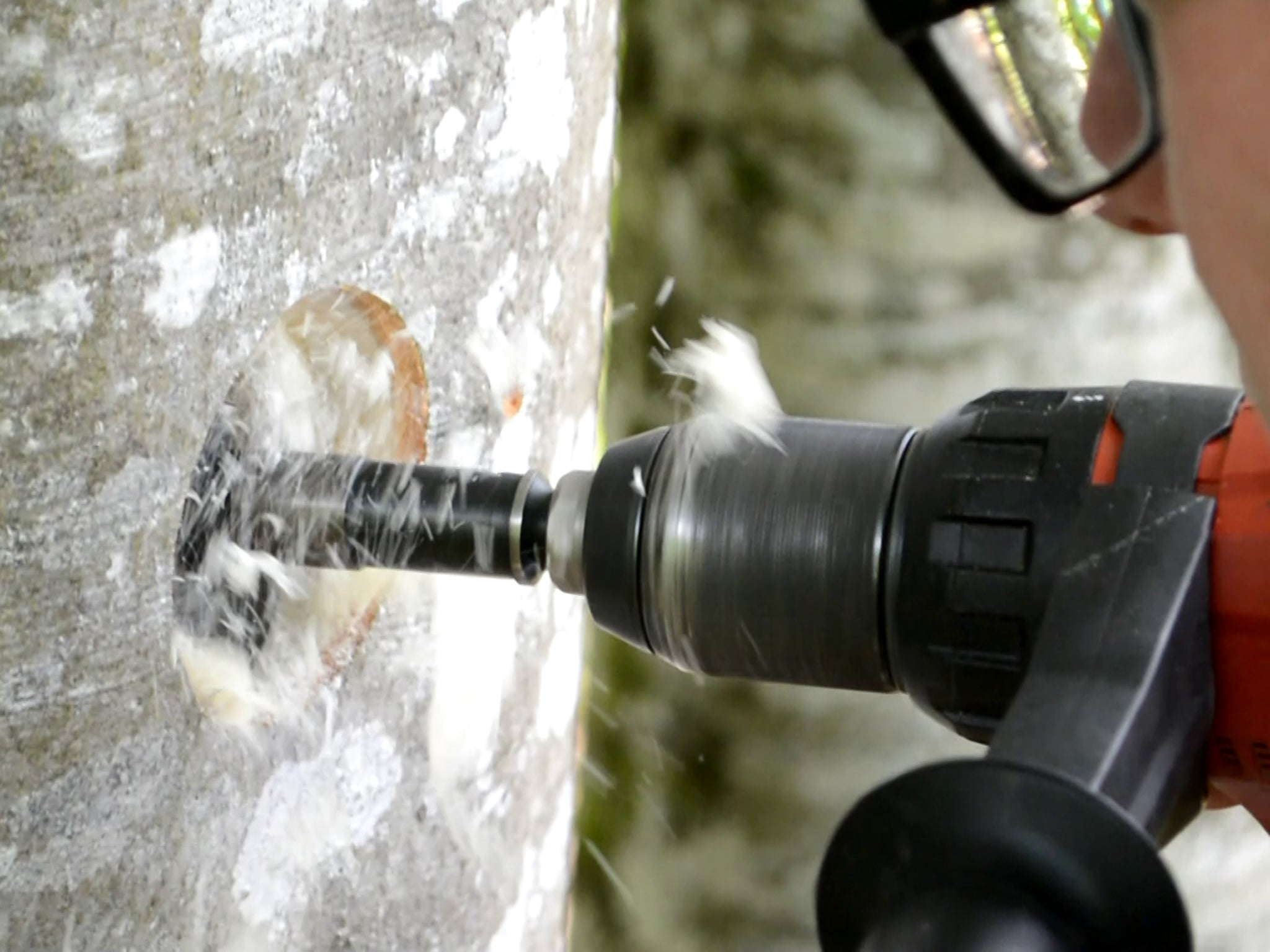
Response to wounds
With ‘damaging’ attachment methods such as tree bolts, a hole is first drilled into the tree and the bolt is screwed tightly into it.
Such injuries are nothing unusual for trees – they have spent millions of years specialising in dealing with branch wounds, crown breaks, lightning strikes, rock falls and other injuries.
Healthy trees react immediately: they store resins and oils to seal the wound and protect it from rot. The wound is then covered with special reaction wood.
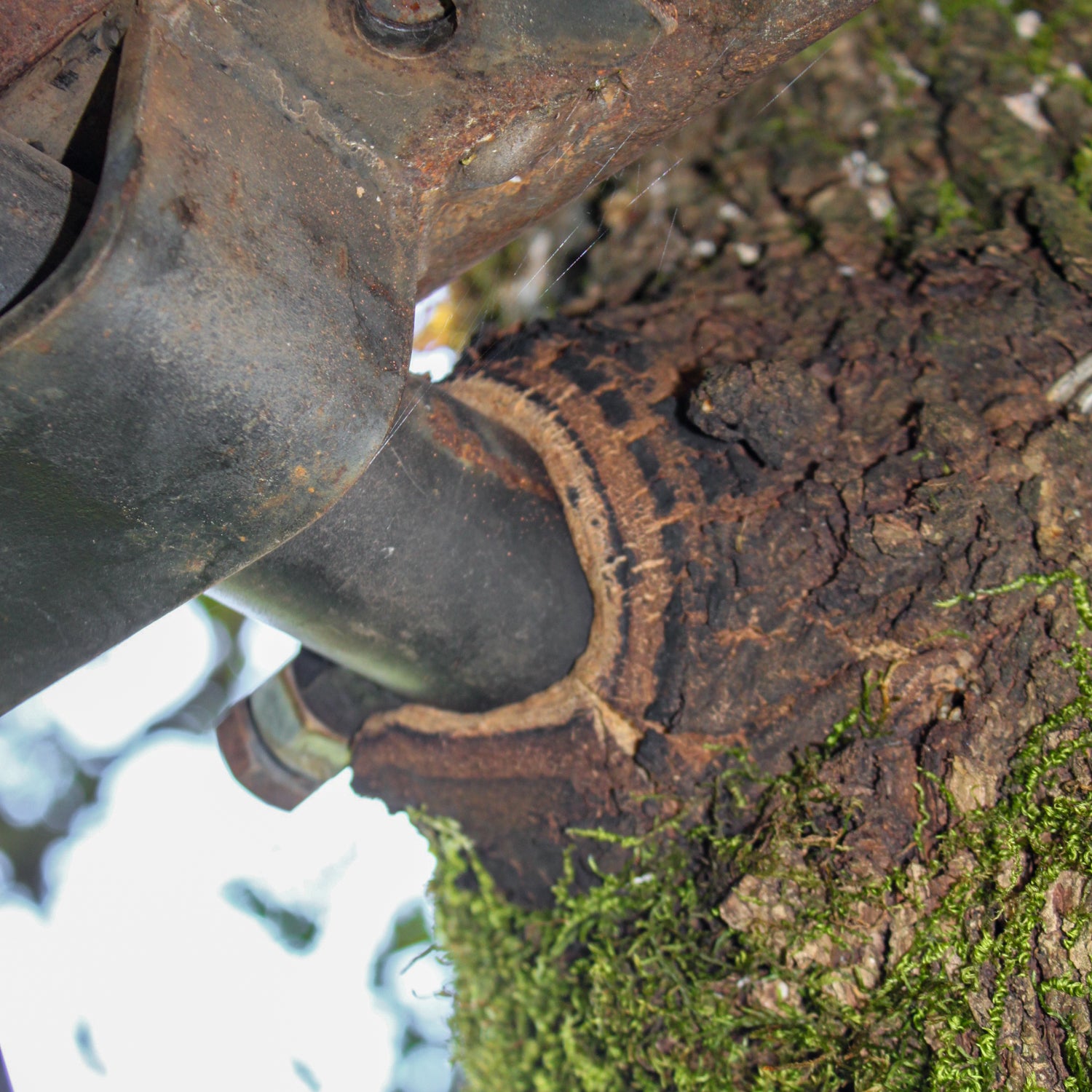
Do fungal spores enter/exit through the borehole?
Fungal spores can enter the tree or escape from the core through drill holes in the tree. When installing a tree bolt, the tool should therefore be thoroughly disinfected and the drill hole quickly sealed with the bolt.
Here too, the tree recognises such injuries and reacts according to the CODIT principle (Compartmentalisation Of Damage In Trees - Alex Shigo):
The tree actively fights the fungal attack. In the case of open wounds, it first reacts to the ingress of air (air embolism) and then protects itself from rot by forming sealing walls made of antifungal substances.
Wound healing in different tree species
Wound healing refers to a tree's ability to overcome injury by sealing off the wound, growing over it and forming reaction wood. Different tree species react differently to open wounds and injuries:
✔✔ Healthy trees with effective wound healing: Here, major interventions such as drilling holes for tree bolts can usually be carried out without any problems.
✔ Healthy trees with good wound healing: These trees can usually cope very well with major injuries.
? Healthy trees with moderate wound healing: These trees are also suitable for installing tree bolts – wounds may resin heavily or open up slightly, and the healing process usually takes a little longer. Therefore, do not use too many bolts here.
❌ Trees with poor wound healing: These trees are not suitable for damaging fastenings and should be left alone; other fastening techniques are preferable here.
Trees with effective wound healing
✔✔ Maple (Acer spp.)
✔✔ Sweet chestnut (Castanea sativa)
✔✔ Oak (Quercus spp.)
✔✔ Hornbeam (Carpinus betulus)
✔✔ Linden (Tilia spp.)
✔✔ Giant sequoia (Sequoiadendron spp.)
✔✔ Plane tree (Platanus×hispanica)
✔✔ European beech (Fagus sylvatica)
✔✔ Tulip tree (Liriodendron tulipifera)
Trees with good wound healing
✔ American
honey locust (Gleditsia
triacanthos)
✔ Douglas fir (Pseudotsuga
menziesii)
✔ Eucalyptus (Eucalyptus spp.)
✔ Japanese
pagoda tree (Sophora japonica)
✔ Pine (Pinus spp.)
✔ Larch (Larix spp.)
✔ Walnut (Juglans spp.)
✔ Black locust (Robinia spp.)
✔ Elm (Ulmus spp.)
✔ Cedar (Cedrus spp.)
✔ Hackberry (Celtis spp.)
Trees with moderate wound healing
- Birch (Betula spp.)
- Pear (Pyrus communis)
- Alder (Alnus spp.)
- Ash (Fraxinus spp.)
- Spruce (Picea spp.)
- Sapindus (Alianthus altissima)
- Hemlock (Tsuga spp.)
- Thuja (Thuja spp.)
- Whitebeam (Sorbus aria)
- False cypress (Chamaecyparis spp.)
- Southern beech (Nothofagus procera)
- Fir (Abies spp.)
- Bird cherry (Prunus avium)
Trees with poor wound healing
❌ Poplar (Populus spp.)
❌ Horse chestnut (Aesculus hippocastanum)
❌ Willow (Salix spp.)
Table as PDF download
You can find more tree species and detailed information about the properties of living trees in our blog!
DOWNLOAD PDF: Table - Wood strength and wound healing of living trees
A healthy and strong tree is not easily disturbed – thanks to its large energy reserves, it can easily survive injuries and other extreme situations.
3. Concerns: Will the tree suffer in the long term from a treehouse?
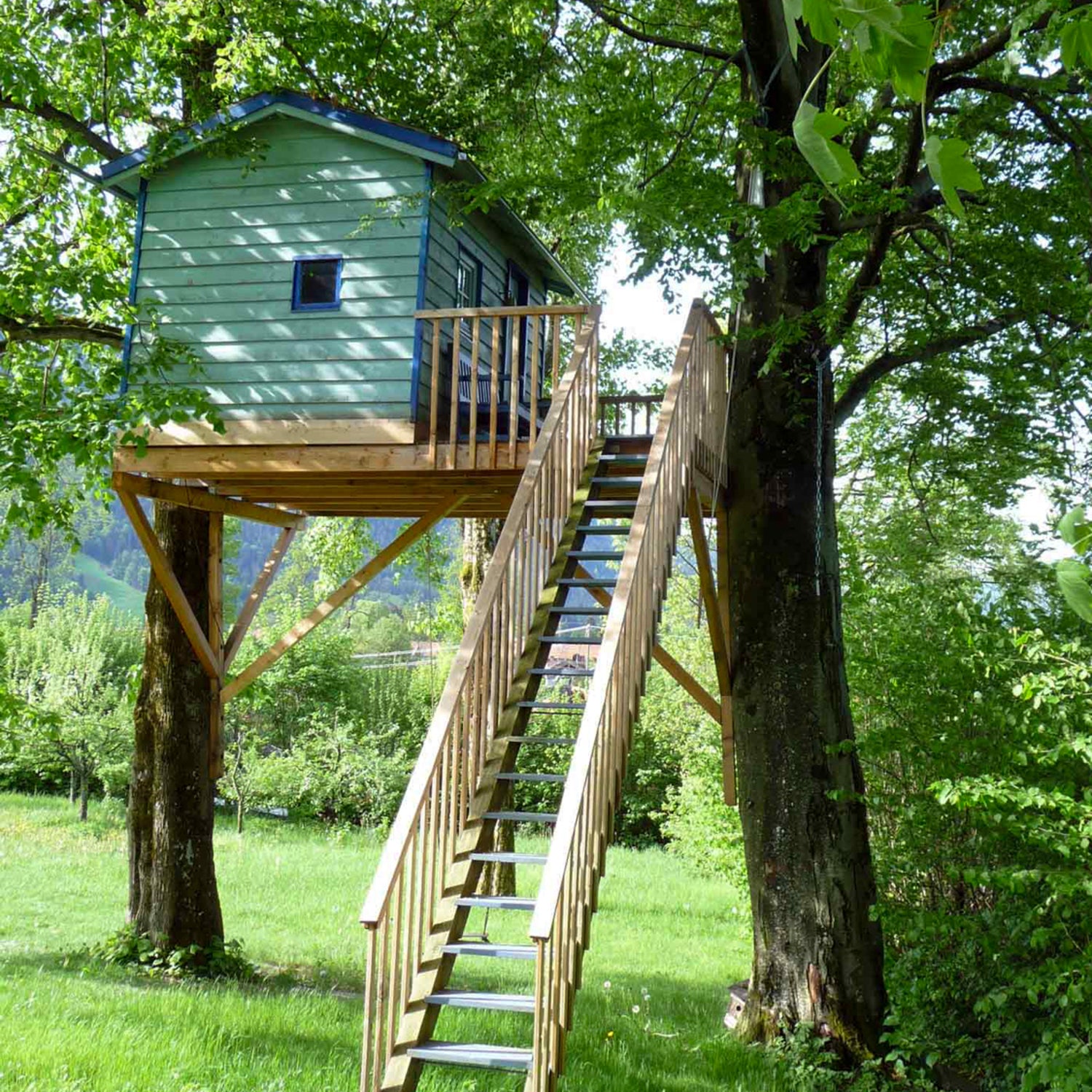
Does a treehouse harm the tree?
Not at all! A global survey Source: Bachelor thesis by Onja Johannes Hardorp, 2017, HNE Eberswalde of 18 professional treehouse builders (including Pete Nelson, Alain Laurens and Andreas Wenning) shows that
out of 2,253 treehouses, only two led to the death of the tree – less than 1 per mille!
Treehouse-Pro Johannes Schelle even raves about his 13-year-old treehouse (see picture) – his two trees, a beech and a lime, always bloom two weeks longer than all the others in the garden.
One thing is clear: if you choose the right tree and fasten the treehouse to the tree in a way that protects it, you have nothing to worry about!
Pro Treehouse Fastenings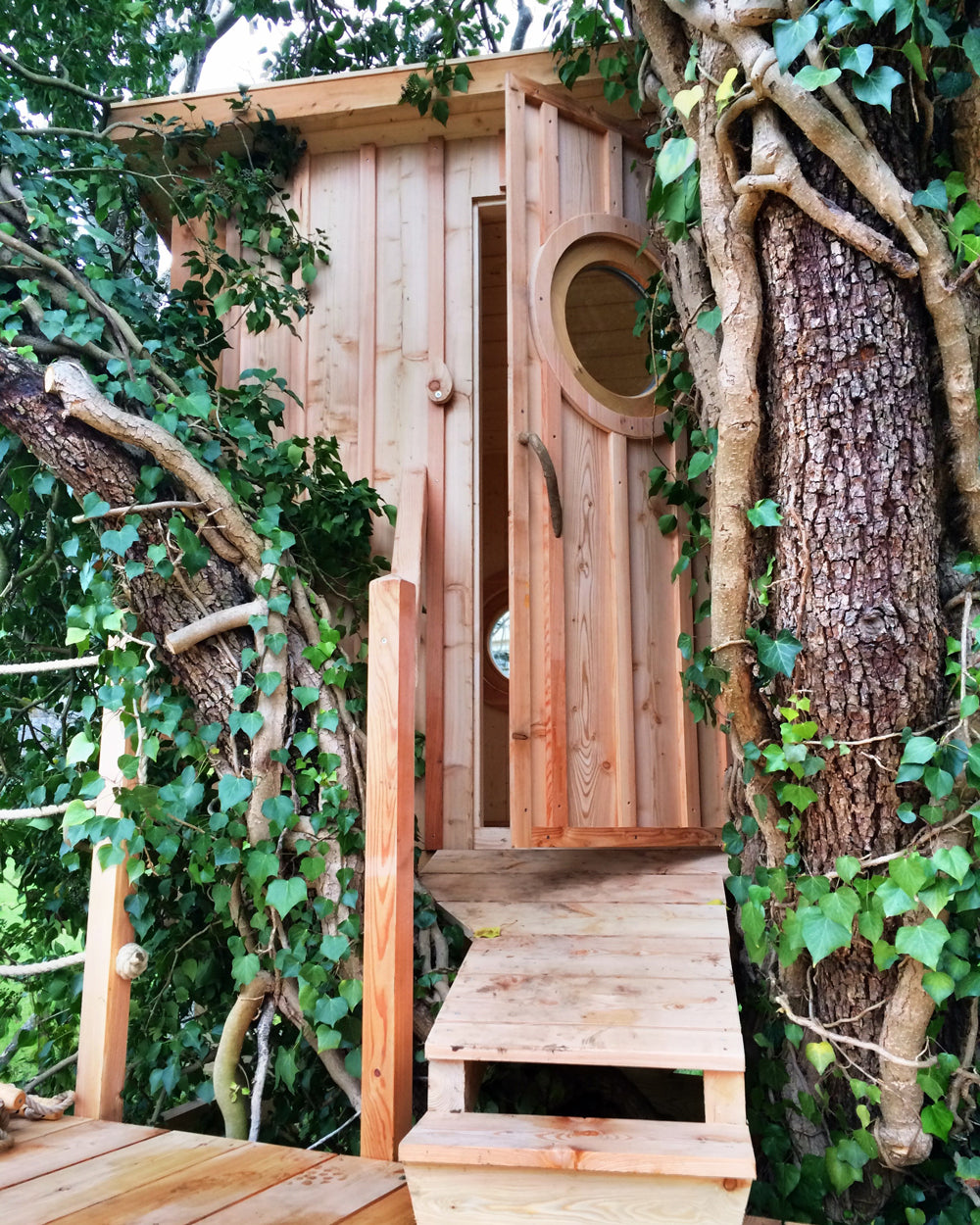
Living proof
This concern disappears when you realise how adaptable and resilient mature trees (ø > 30 cm) are. Those that have survived the difficult years of growth have already demonstrated enormous vitality.
Trees face many challenges in the course of their lives – from extreme weather events such as droughts, storms, hail or frost to human intervention such as soil compaction, root damage or improper pruning.
However, thanks to large energy reserves from carbohydrates and fats, as well as a structure that far exceeds daily stresses, healthy trees are well equipped to cope with such extreme situations. No wonder they are among the oldest organisms on Earth!
Trees are true masters of survival and adapt quickly to new situations: treehouses are a prime example of this!
4. Conclusion – It all comes down to the right technique
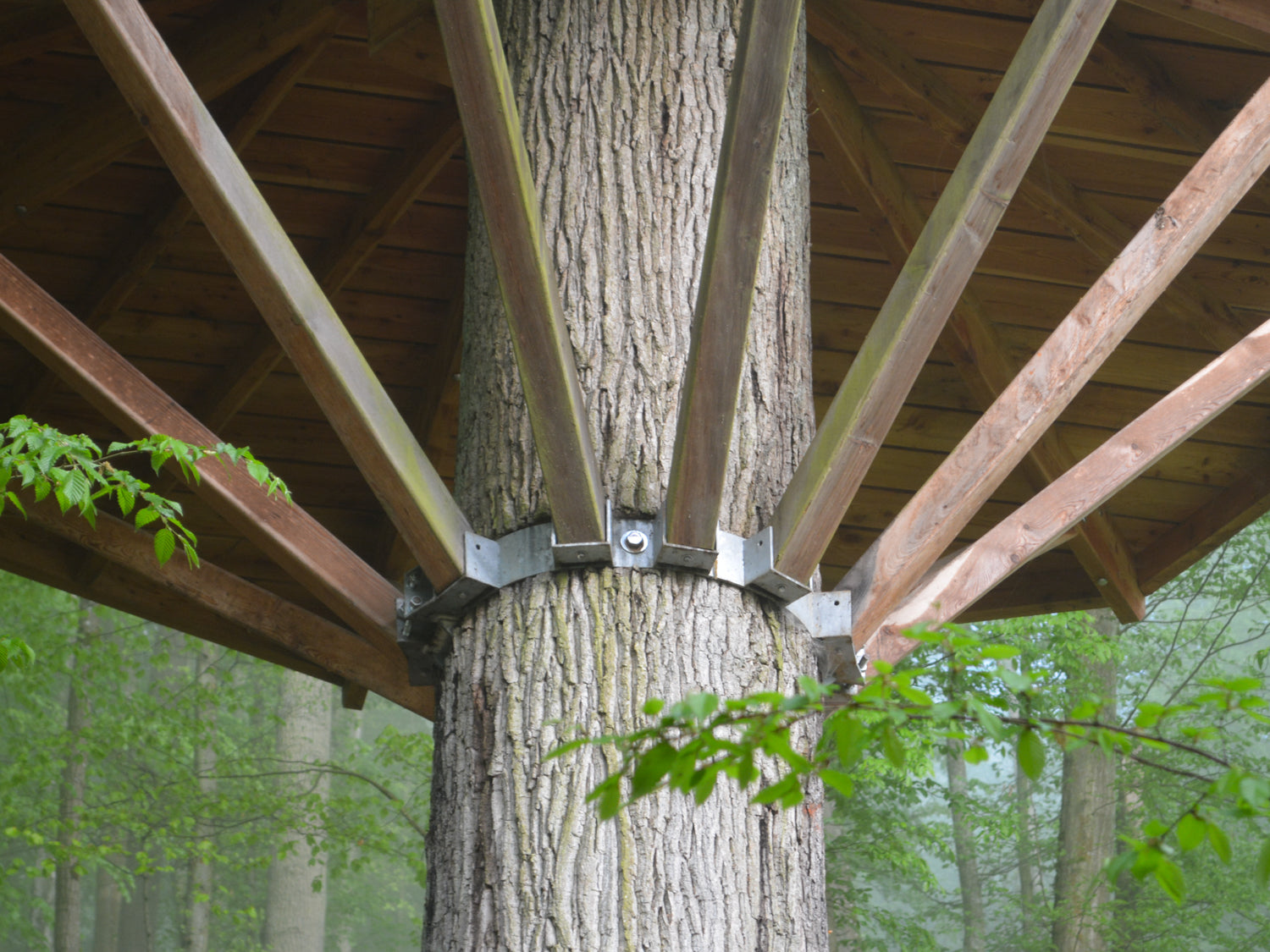
Incorrectly secured – the tree MUST be able to grow!
We understand the initial concerns all too well – we too were reluctant to drill into trees at first and looked for ‘damage-free’ alternatives to treehouse fastenings. Like many other treehouse builders and climbing forest operators, we used to rely on steel rings and clamping beams to protect the tree.
But about 10 years later, we all realised that these methods are anything but sustainable, as trees grow surprisingly quickly in width (3–15 mm per year).
The long-term consequences?
Squeezed trunks, interrupted nutrient supply, dangerous breaking points – and on top of that, expensive maintenance work and dissatisfied customers.
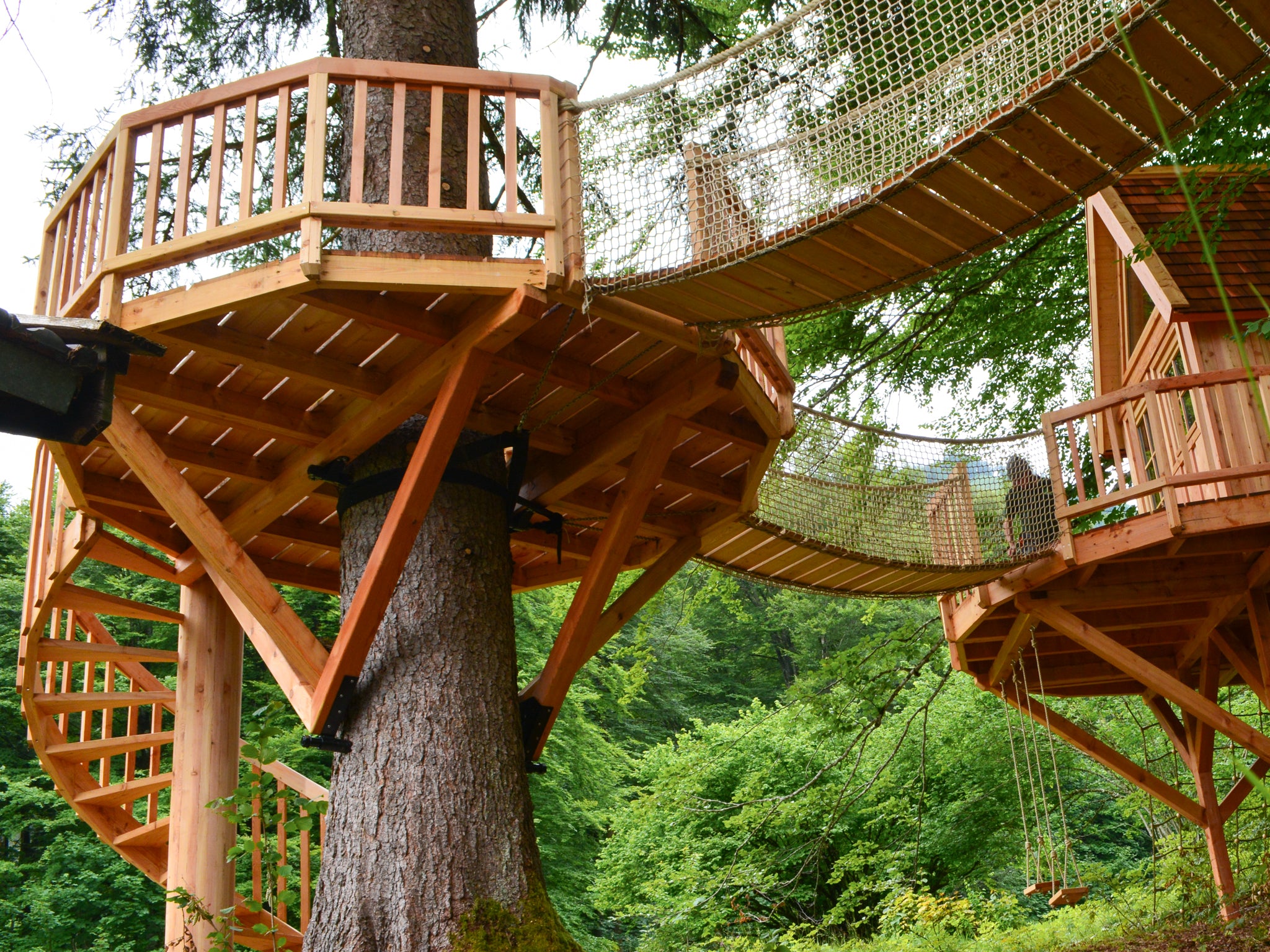
The modern solution: Tree Bolts
How do you attach a heavy construction to a tree without damaging it?
This requires long-term thinking: we need a fastening technology that can bear enormous loads and still allow the tree to grow unhindered in width.
The solution: tree bolts
Thanks to pioneers in the USA Michael Garnier, Pete Nelson, Charles Greenwood, ..., we know that trees and tree bolts work together perfectly for decades.
All you need is a healthy tree that is thick enough!
GTS Treehouse Fastenings
✔ Special screw for living trees ✔ Safe & gentle on trees ✔ Proven and tested for 25 years ✔ Recommended by professionals ✔ 100% made in Germany
Tree bolts are currently the most sustainable, safest and lowest maintenance method of securing tree houses.
